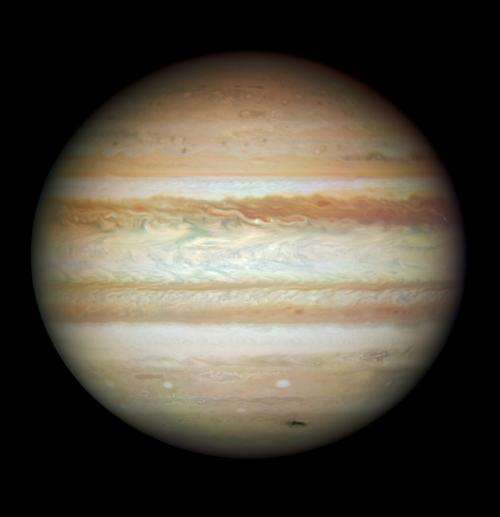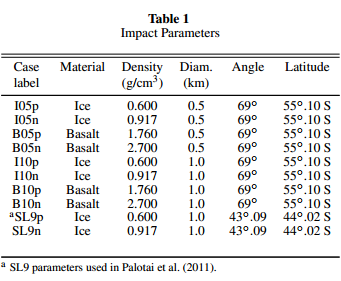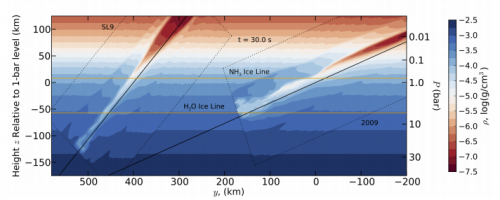March 30, 2012 report
Simulations unravel mysteries of 2009 Jupiter impact

(PhysOrg.com) -- During July of 1994, both amateur and professional astronomers were captivated as comet Shoemaker/Levy 9 broke apart and slammed into the atmosphere of Jupiter. While these types of impacts are generally rare, a second impact event occurred fifteen years later in July of 2009. The object responsible for the 2009 impact was not directly observed, so astronomers could only make inferences about the object based on the disturbances in the Jovian atmosphere, as shown in the image above.
New research by Jarrad Pond (University of Central Florida), and a team from the University of Central Florida and University of California, Santa Cruz aims to help determine the object responsible for the 2009 impact on Jupiter. Without a direct observation of the event, the team used numerical simulations in order to better understand the object responsible for the large disturbance of the Jovian atmosphere.
Using three dimensional hydrodynamics code, the team modeled the impacts of eight simulated impactors. The team used impactors of .5 and 1km, with different densities and compositions (basalt or ice). By using the same impact angle (69 degrees) and impact velocity 61.4 km/sec), the team was able to narrow down the potential size and composition of the object responsible for the July 2009 impact.

By comparing their simulations of the 2009 impact event with simulations of the Shoemaker-Levy 9 events, differences in plume development were revealed. The angle of the 2009 impact appears to have led to a shallower impact depth, as well as a smaller and slower plume. The team's simulations revealed that the 0.5km impactor events produced smaller and slower plumes, while the 1km impactor events produced larger and faster plumes.
The penetration depths of the impactors appear to be related to the nature of the impactor. Given a fixed impact angle, the larger and denser the impactor, the deeper the object would penetrate into the Jovian atmosphere. When the team compared the aftermath of the Shoemaker-Levy 9 impact and the 2009 impact, they noticed several differences. The disturbances in Jupiter's atmosphere from the Shoemaker-Levy 9 impact were significantly larger and faster than that of the impact disturbances from the 2009 incident angle.

impact angle (right). The undisturbed Jovian atmospheric density profile is plotted in the background. Image Credit: Pond, et al.
Of the eight objects modeled in the team's simulations, most of the 0.5km objects cannot account for the disturbances seen in Jupiter's atmosphere from the 2009 impact. The smaller objects appear to not penetrate far enough to explain ammonia observations in Jupiter's stratosphere. Given the results of the 0.5km objects, the team was able to set a lower limit on the size and density estimates for the July 2009 impactor. Although most of the 0.5km objects were ruled out, the 0.5km basalt impactor, and all of the 1km impactor plumes penetrated far enough into Jupiter's atmosphere to reach the ammonia ice cloud level in the troposphere.
The team mentions that more simulations are necessary in order to better constrain the impact characteristics with additional parameters. Additionally, the team asserts that ammonia transport from the upper troposphere to the stratosphere by means of the impact plumes must be investigated. With additional research, the team hopes to further refine the possible causes of the atmospheric disturbances related to the July 2009 Jupiter impact event.
The team's work can be found in the February 1st. issue of The Astrophysical Journal (745:113), or via ArXiv.
More information:
iopscience.iop.org/0004-637X/745/2/113
arxiv.org/pdf/1203.5356v1.pdf
© 2012 PhysOrg.com





















